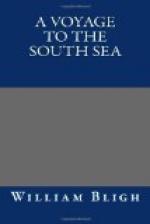On the 19th at daylight we discovered a cluster of small rocky islands bearing east by north four leagues distant from us. We had seen no birds or anything to indicate the nearness of land except patches of rock-weed, for which the vicinity of New Zealand sufficiently accounted. The wind being at north-east prevented our near approach to these isles; so that we were not less than three leagues distant in passing to the southward of them. The weather was too thick to see distinctly: their extent was only 3 1/2 miles from east to west and about half a league from north to south: their number including the smaller ones was thirteen. I could not observe any verdure on any of them: there were white spots like patches of snow but, as Captain Cook, in describing the land of New Zealand, near Cape South, says, in many places there are patches like white marble, it is probable that what we saw might be of the same kind as what he had observed. The westernmost of these islands is the largest; they are of sufficient height to be seen at the distance of seven leagues from a ship’s deck. When the easternmost bore north I tried for soundings, being then 10 miles distant from the nearest of them, and found bottom at 75 fathoms, a fine white sand: and again at noon, having run six leagues more to the east-south-east, we had soundings at 104 fathoms, a fine brimstone-coloured sand. The latitude of these islands is 47 degrees 44 minutes south; their longitude 179 degrees 7 minutes east, which is about 145 leagues to the east of the Traps, near the south end of New Zealand. Variation of the compass here 17 degrees east. While in sight of the islands we saw some penguins, and a white kind of gull with a forked tail. Captain Cook’s track in 1773 was near this spot, but he did not see the islands: he saw seals and penguins hereabouts, but considered New Zealand to be the nearest land. I have named them after the ship the Bounty Isles.
Sunday 21.
This day we saw a seal, some rock-weed, and a great many albatrosses. I tried for soundings but found no bottom at 230 fathoms depth. Our latitude 47 degrees 32 minutes south, longitude 182 degrees 36 minutes east.
October. Thursday 2.
Were in 40 degrees 27 minutes south latitude and 214 degrees 4 minutes east longitude. It being calm, and a number of small blubbers about the ship, I took up some in a bucket, but I saw no difference between them and the common blubbers in the West Indies. We frequently in the night-time observed the sea to be covered with luminous spots caused by prodigious quantities of small blubbers that, from the strings which extend from them, emit a light like the blaze of a candle, while the body continues perfectly dark.
Friday 3.
The 3rd in the morning we saw a seal. Captain Cook has remarked seeing seaweed when nearly in the same place. Our latitude 40 degrees 21 minutes south, longitude 215 degrees east. Variation of the compass 7 degrees 45 minutes east. Being now well to the eastward of the Society Islands I steered more to the northward.




